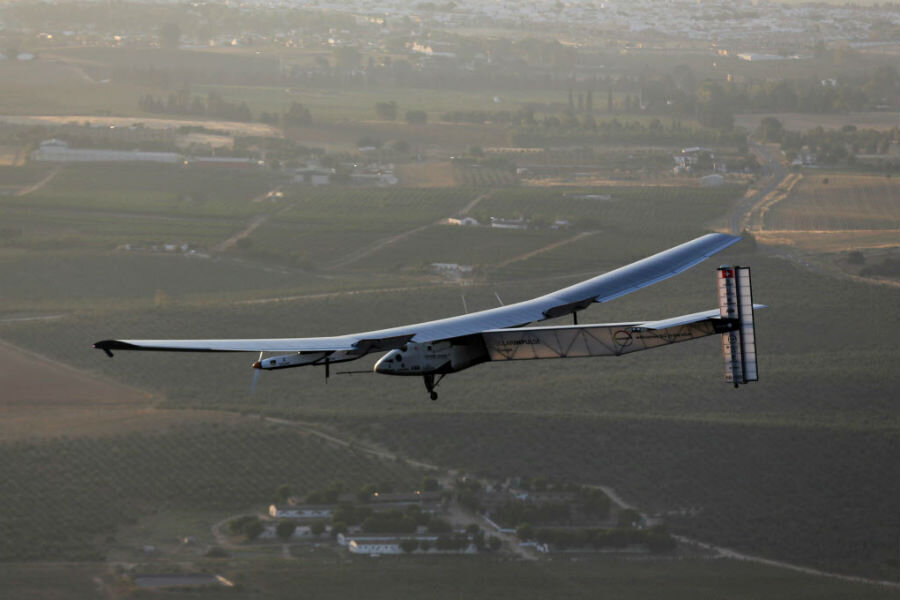Powered by the sun, aircraft makes historic transatlantic flight
As he soared over the expanse of the Atlantic Ocean at an altitude of 28,000 feet, pilot Bertrand Piccard saw whales leaping out of the ocean to catch mouthfuls of air and a lone iceberg that had drifted from northern waters. When darkness fell, he lowered his aircraft to 5,000 feet to conserve energy.
The solo pilot continued this way for four days and four nights, drawing slowly but steadily closer to his destination – the European continent.
Like the British aviators John Alcock and Arthur Brown, who made the first transatlantic flight in 1919; Charles Lindbergh, who made the first solo transatlantic flight; or Amelia Earhart who became the first female to complete that feat in 1932, when Mr. Piccard set his plane down in Seville, Spain, on Thursday, he too was making transatlantic history: the first solar-powered flight across the Atlantic.
"The Atlantic is the symbolic part of the flight,” Piccard, who has also circumnavigated the world by nonstop balloon, told The Guardian Thursday morning from the air. “It is symbolic because all the means of transportation have always tried to cross the Atlantic, the first steamboats, the first aeroplane, the first balloons, the first airships and, today, it is the first solar-powered aeroplane."
This success comes, potentially, sandwiched between two other firsts for the solar plane, called the Solar Impulse 2. Last June, Piccard’s partner André Borschberg made history with the longest solo flight in aviation history for the nearly five-day, 4,000-mile crossing from Japan to Hawaii over the Pacific Ocean. The other is upcoming – when the Solar Impulse 2 touches down in Abu Dhabi, United Arab Emirates, the plane, and its two alternating Swiss pilots, will have made the world’s first circumnavigation in a solar plane.
That was the goal that pilots and business partners Piccard and Mr. Borschberg set out to achieve when they took off last March in Abu Dhabi. But they say they aren't motivated by the thought of a world record or aeronautic innovation.
“The goal is not to change aviation, as Charles Lindbergh did, but to inspire people to use [renewable] technologies and show people they can use these technologies every day to have a better quality of life,” Piccard told The Guardian.
While their plane travels at roughly 30 miles per hour, it uses no fuel and produces no pollution, drawing power from 17,000 solar cells, which cover the upper surface area of the wings and supply the plane’s four engines with renewable energy.
The Solar Impulse 2 has room for one person and weighs about as much as a car, yet its 72-meter wingspan stretches wider than a Boeing 747. The plane carries four large lithium batteries that charge during the day, allowing the plane to fly at night.
Since leaving Abu Dhabi the Solar Impulse 2 has stopped in Oman, two cities in India, Myanmar, several places in China, Japan, and multiple locations in the United States.
The pilot and their team of 50 engineers and technicians have had to react to set-backs along the way. After the triumphant Pacific crossing to Hawaii, piloted by Borschberg, the plane needed battery repairs and then had to wait for the season to shift for more sunlight, so it remained downed in a hangar in Hawaii for ten months, reported the BBC.
Weather dictates flight patterns, as well. Piccard originally wanted to fly into Paris, mimicking Mr. Lindbergh’s historical flight, but stormy weather necessitated a course change.
"If we would have arrived in Paris like we wished, it would have been very complicated because we would have had to cross a lot of air traffic controls,” project team member Yves-André Fasel, who coordinates with air traffic control, told the BBC.
The team is used to last-minute planning and flight alterations. Even the last stretch of the trip, as the plane makes its way back to Abu Dhabi will be determined on the fly.
That final voyage will be broken up into two or three legs, depending on weather, and Mr. Fasel says, military airspace restrictions, if the plane flies via North Africa.
The pilots are ready for what’s next having gotten this far on a mindset of the future-is-now:
“The fact I can stay [airborne] without fuel or pollution for four days and four nights is something so new,” Piccard told The Guardian. “I have the impression I am in a science fiction story and it’s like I am already in the future. And then I look outside and I say, well it’s not the future, it’s now."






